How to Feed a Sourdough Starter with Bread Flour
When it comes to sourdough, everyone likes to focus on the wild yeasts, but a sourdough starter isn’t all yeast; it’s a mix of yeasts, lactic acid-producing bacteria, and acetic acid-producing bacteria.
In wild sourdough starters, yeasts ferment wheat carbohydrates into alcohol and carbon dioxide. Then, bacteria in the sourdough starter metabolize the alcohols produced by the yeasts into acetaldehyde and then into acetic acid… making it sour.
There are many ways to feed a sourdough starter, and no one way is “correct.” Sourdough starters can be thicker and drier or thinner and more hydrated. You can also use any type of flour to feed a sourdough starter, but here we will focus on bread flour.
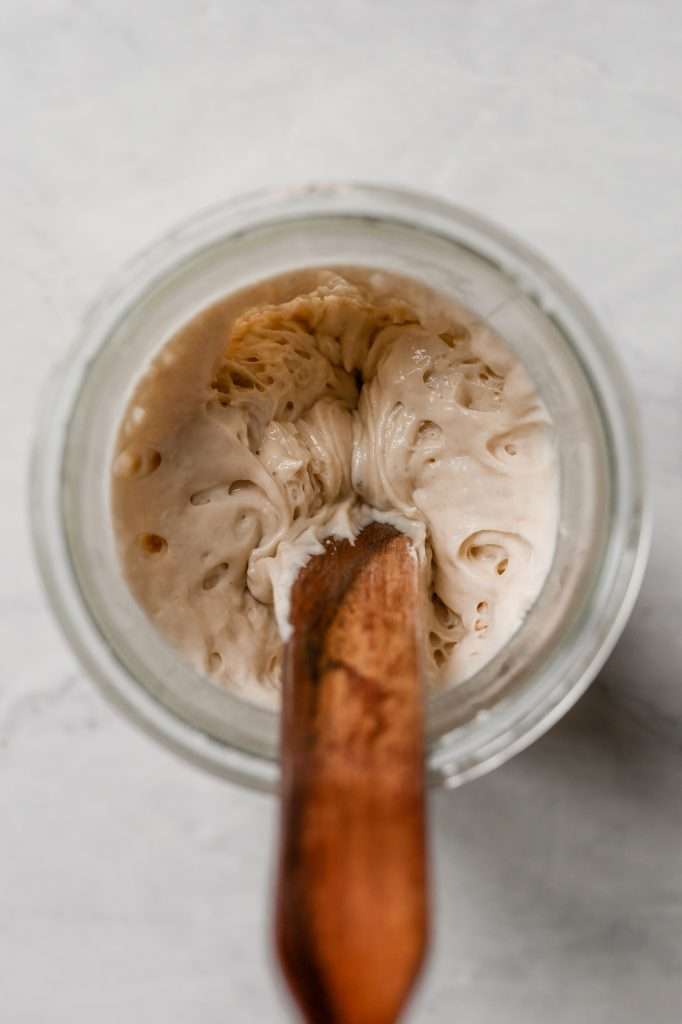
How to Feed a Sourdough starter and Keep it Healthy
Sourdough is fascinating because so many different types of microbial metabolism and fermentation are happening all at once. Yeasts make bubbles and visible expansion in a starter, but bacteria make all the flavor. When more good bacteria are present, they can help boost yeast populations by feeding them usable acids and eliminating waste products (alcohol).
I’m sure you’ve heard the phrase “discard and feed.” The point of discarding and feeding your sourdough starter is to replenish the microbe’s food source so that the accumulation of waste products does not kill the yeast and bacteria.

Ingredients and Tools to Feed a Sourdough Starter
- Flour: I’ve used many flours to make a sourdough starter. For this recipe, we will use organic bread flour. The type of flour you use will influence the flour-to-water ratio you should use. Whole grain flour, especially sprouted flour, works well with a 1:2 flour-to-water ratio. White flour, like bread flour and all-purpose, work best between a 1:1 and 2:1 flour-to-water ratio.
- Water: Filtered water is best, but you can use tap water if you think you have good tap water. I use tap water that has been filtered through our water filter pitcher.
- Glass Jars and Cheesecloth: I like to use a glass weck jar for my starter. The mixture needs access to air to grow well, so you can use the glass weck jar lid without sealing it, or something like cheesecloth with a rubber band.
- Kitchen Scale: If you frequent our blog, you should already have one of these on hand. You can find a good kitchen scale option HERE.
- Environment: Temperature is important when it comes to growing healthy yeast and bacteria in a sourdough starter. Your kitchen temperature should be between 60-80 degrees F. Colder temperatures mean slower growth.

How to Feed a Sourdough Starter (thinner, hydrated)
When first starting your sourdough starter, in the first seven days, it’s best to start with a thinner starter. You may not see your starter hold a rise for long, but it’s better for getting the microbes established.
The best ratio to get things going is 1:1. So for example that would be 50 grams of bread flour, 50 grams of water, and 50 grams of established starter.
Bread flour sourdough starters fed 1:1 will usually rise and bubble up in 4-6 hours, then fall back down to look flat.
How to Feed a Sourdough Starter (thicker, dry, that holds a rise)
So many people email me saying things like “I fed my starter 8 hours ago, and I see bubbles, but it didn’t rise.”
It did rise, it just fell back down.
If you want to feed your starter before bed or work and see it 8 hours later, still risen and bubbly, you need to make a thicker starter. If you want to snap pics of your starter, and you expect it to look like the ones on Pinterest and Instagram you need to make it thicker.
For a thick bread flour starter, you can feed a 2:1 ratio of bread flour to water. So, for example, that would be 100 grams of bread flour, 50 grams of water, and 50 grams of established starter. It will be very thick, and it may dry out a little on the top, but it will hold a rise you can see.

How to Feed a Sourdough Starter with Bread Flour
The feeding ratio is adjustable in these instructions. I suggest following the 1:1 ratio for the first 7 days; then you can adjust to a thicker starter that holds a “photo-worthy” rise longer.
Step One (Day 1)
- In a bowl combine: 50 grams of organic bread flour and 50 grams of water
- Use a spatula to combine the flour and water. Stir until there are no clumps and the mixture is smooth.
- Scoop the mixture into a clean glass jar.
- loosely set a lid on the top or secure a breathable covering to the jar (i.e. cheesecloth) and leave the mixture on the counter for 24 hours.
Step Two (Day 2)
- Stir sourdough starter mixture.
- Add in 50 grams of organic bread flour
- Add 50 grams of water.
- Mix and scrape down the sides. Replace a breathable lid. Leave the mixture on the counter for 24 hours.
Step Three (Days 3-7, Feeding and Discarding)
You can feed your starter however much you want here, less or more, just keep the ratio the same.
- to a clean bowl add: 50 grams sourdough starter mixture from day 2, 50 grams of organic bread flour, 50 grams of water
- Stir until evenly combined, and scoop into a clean jar.
- Replace the breathable lid and allow it to ferment for 24 hours.
- Discard any remaining original starter mixture. Or you can find fun ways to use sourdough starter discard, like this muffin recipe.
- Repeat every 24 hours through day 7.
Step Four (The Night Before Baking)
You can feed your starter however much you need to here, less or more. If you plan to bake five loaves, for instance, you can feed your entire starter 300 grams of flour and 300 grams of water in a large bowl and cover it.
- 8 hours before starting a baking recipe, in a bowl, combine: All of the starter, 100 grams of organic bread flour, 100 grams of water
- Stir until evenly combined.
- Scoop the starter into a large jar.
- Place the breathable lid on the jar and allow it to ferment for 12 hours.
Day 8 (Baking Day)
- Perform a float test by dropping a teaspoon of starter into a cup of room-temperature water. If it floats, it’s ready for use. If your starter does not float, continue to feed and discard until it passes the float test.
- If your starter passed the float test, put 50 grams of starter aside and continue feeding (using steps 3 and 4). Use the rest of the starter for your baking recipe.
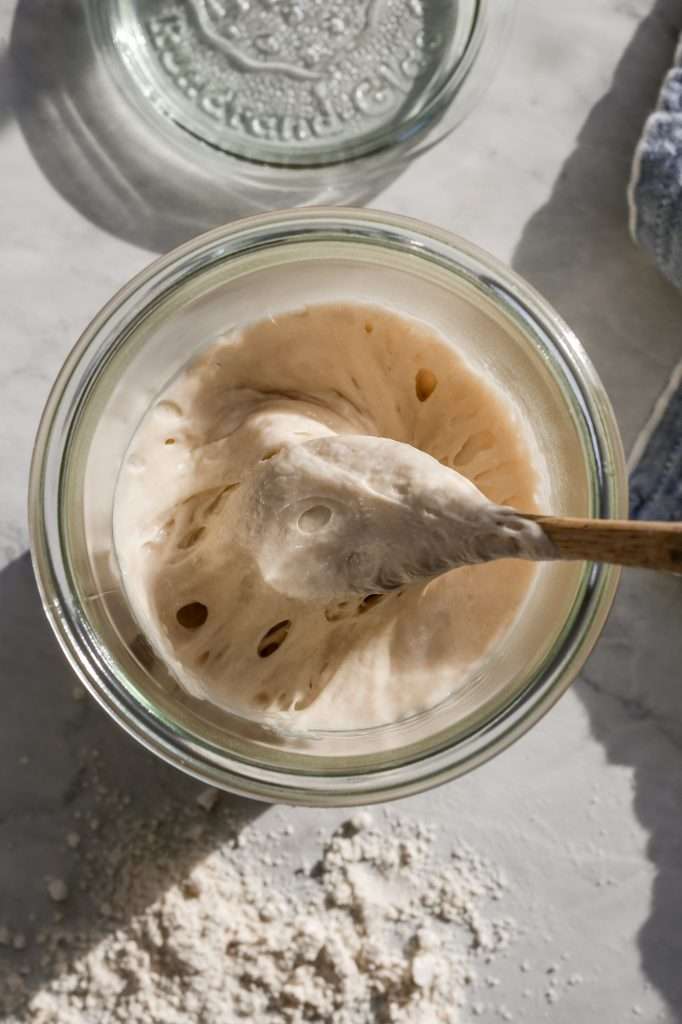
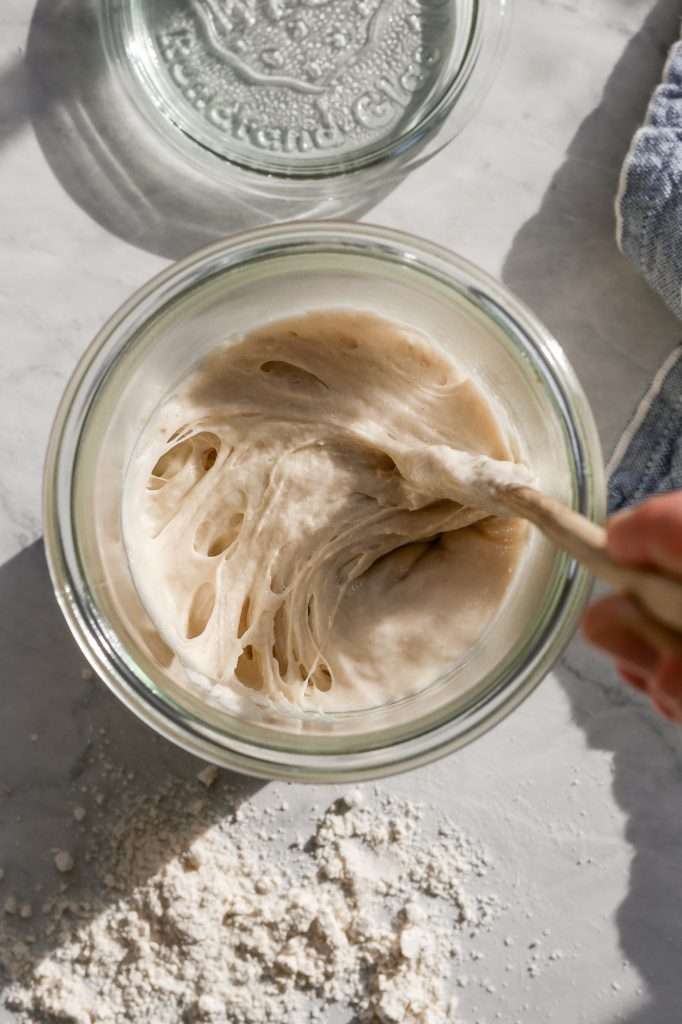
How to Feed a Sourdough Starter, Quick Option (2 Days Total)
This is a fun way to speed up the sourdough starter process. Adding in a little raw, wild-fermented sauerkraut brine helps to boost the Lactobacillus population in the starter. This means that the mixture gets more sour and flavorful faster!
To make a sourdough starter with sauerkraut brine, simply follow the directions in the recipe, but add in 2 tablespoons of sauerkraut on the first day. After the first day discard and feed with flour and water like normal.
With the addition of sauerkraut brine, you should have a bubbly starter within two days.
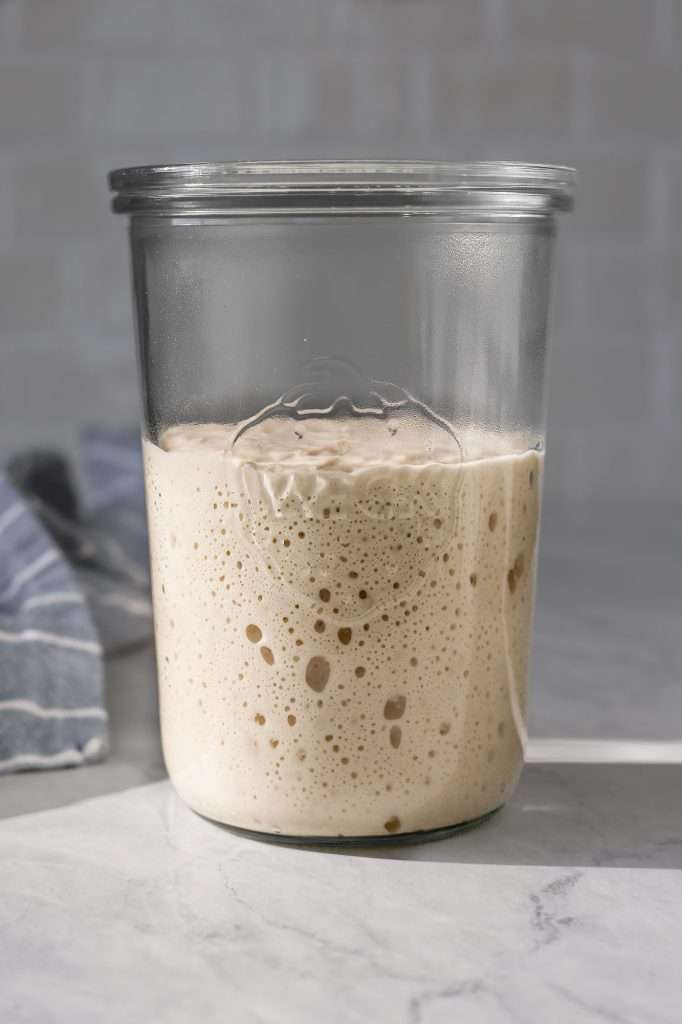
How to Feed a Sourdough Starter After Refrigerating
If you’ve used some of your sourdough starter to bake, and you do not plan on using your starter again anytime soon, you can hibernate it.
- In a clean jar add: 50 grams starter mixture, 50 grams organic bread flour, 50 grams water
- Stir until evenly combined, and scrape down the sides of the jar. let it ferment for a few hours at room temp, then close it with a solid lid and place it in your refrigerator.
- To revive your starter, take it out of the fridge and start discarding a feeding it again.
Easy Sourdough Baking Recipe
- Dutch Oven Sourdough Boule Recipe
- Rustic Rosemary Sourdough Bread
- The Best Maple Pecan and Cinnamon Sourdough Bread Recipe
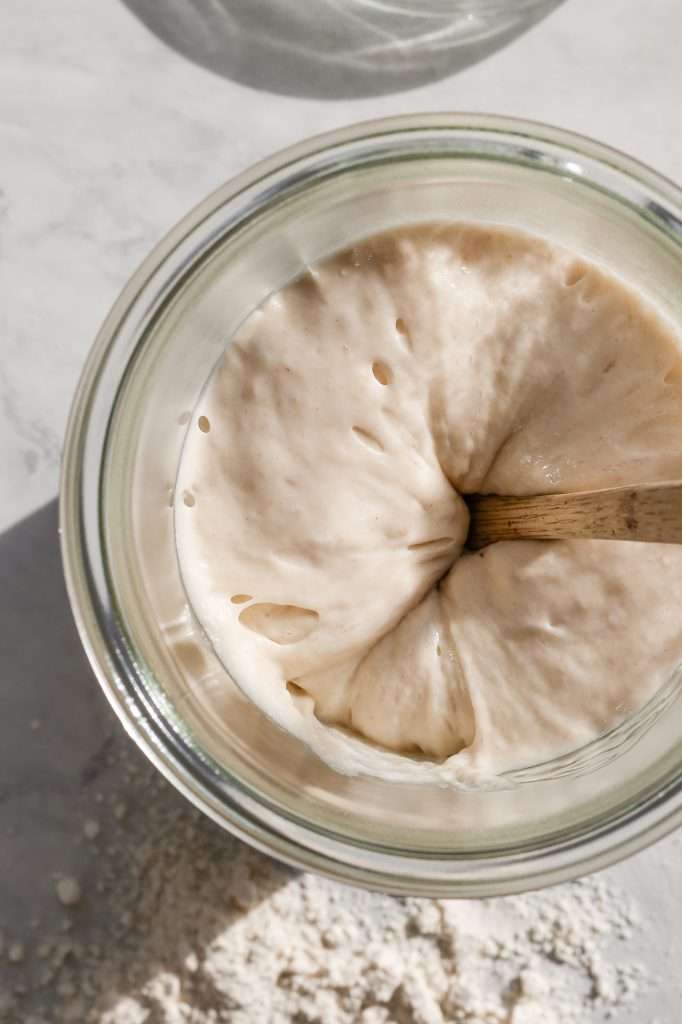
Things You May Need:
Print
How to Feed a Sourdough Starter with Bread Flour
Learn how to feed a sourdough starter with bread flour. Feeding a sourdough starter requires two ingredients, and in just seven days, you’ll have a healthy sourdough starter for baking flavorful, naturally leavened bread!
- Prep: 10 Minutes
- Total Time: 7 Days
Ingredients
- Organic Bread Flour
- Water
Instructions
- The feeding ratio is adjustable in these instructions. I suggest following the 1:1 ratio for the first 7 days; then you can adjust to a thicker starter that holds a “photo-worthy” rise longer. Please read the blog post above this recipe for more on this.
- (Day 1) In a bowl combine 50 grams of organic bread flour and 50 grams of water.
- Use a spatula to combine the flour and water. Stir until there are no clumps and the mixture is smooth.
- Scoop the mixture into a clean glass jar.
- Loosely set a lid on the top or secure a breathable covering to the jar (i.e. cheesecloth) and leave the mixture on the counter for 24 hours.
- (Day 2) Stir sourdough starter mixture.
- Add 50 grams of organic bread flour and 50 grams of water to the starter mixture in the jar. Mix and scrape down the sides.
- Replace a breathable lid. Leave the mixture on the counter for 24 hours.
- (Days 3-7, Feeding and Discarding) to a clean bowl add 50 grams sourdough starter mixture from the previous day, 50 grams of organic bread flour and 50 grams of water
- Stir until evenly combined, and scoop into a clean jar.
- Replace the breathable lid and allow it to ferment for 24 hours.
- Discard any remaining original starter mixture. Or you can find fun ways to use sourdough starter discard here.
- Repeat steps 9 through 12 every 24 hours until you reach 7 days.
- (The Night Before Baking) You can adjust the amounts here and feed your starter however much you need to.
- 8 hours before starting a baking recipe, in a bowl combine: All of the starter, 100 grams of organic bread flour, 100 grams of water and stir until evenly combined.
- Scoop the starter into a large jar with plenty of room for tripling in size. Place the breathable lid on the jar allow it to ferment for 12 hours.
- (Baking Day) Perform a float test by dropping a teaspoon of starter into a cup of room-temperature water. If it floats, it’s ready for use. If your starter does not float, continue to feed and discard until it passes the float test.
- If your starter passed the float test, put 50 grams of starter aside to continue feeding as in steps 9-12. Use the rest of the starter for your baking recipe.
Notes
- This recipe is formulated using organic bread flour. If you use a different type of flour your starter will be a different consistency and texture.
- The type of flour you use will influence the flour to water ratio you should use. Whole grain flours, especially sprouted flours, work well with a 1:2 flour to water ratio. White flours like bread flour and all purpose work best with a ratio between 1:1 and 2:1 flour to water.
- You may notice some early watery separation. This is normal and just means you need to adjust the flour to water ratio. Simply add more flour to your feedings to thicken the starter.





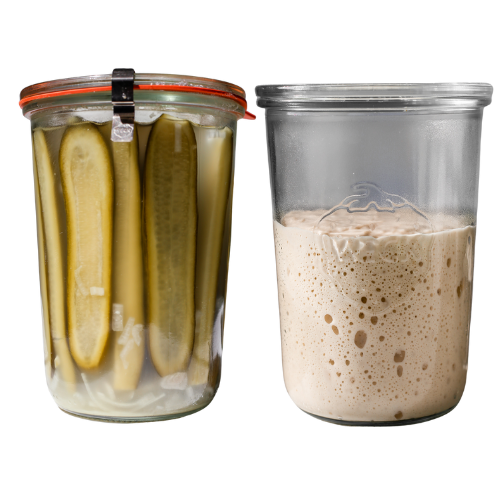
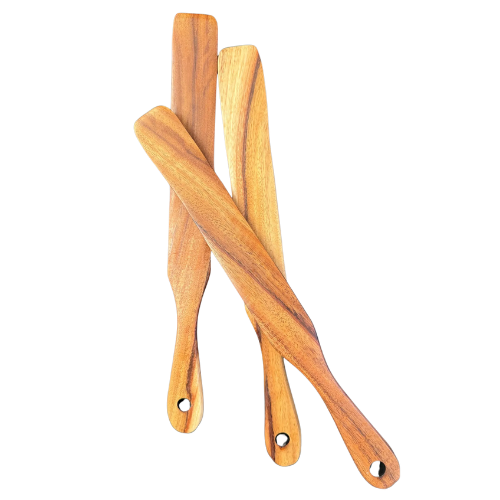
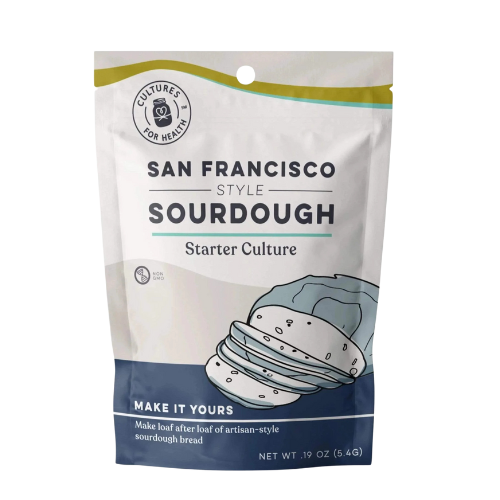

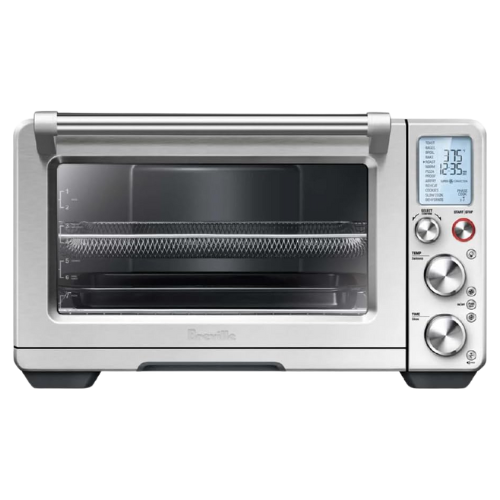

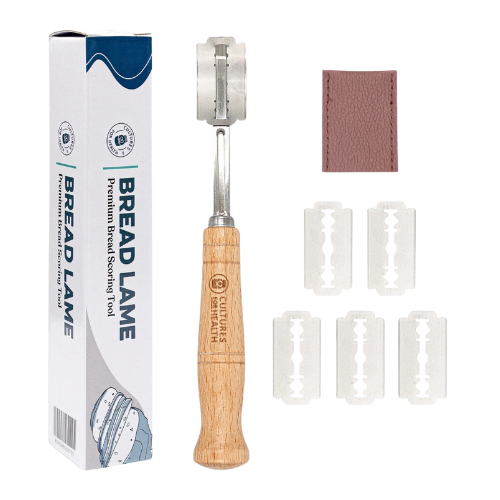


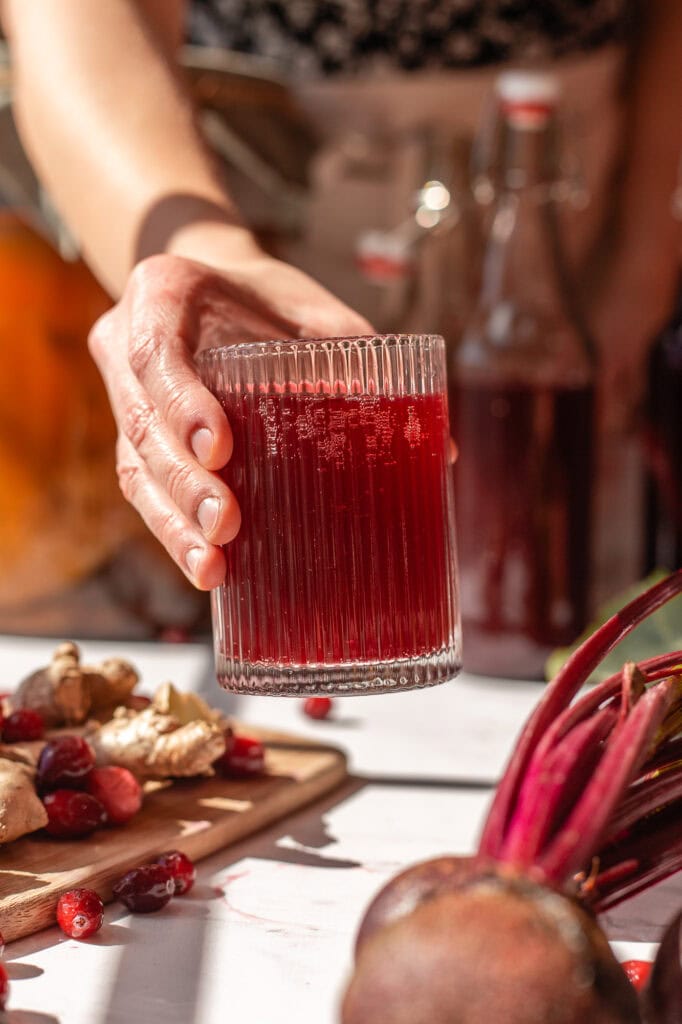









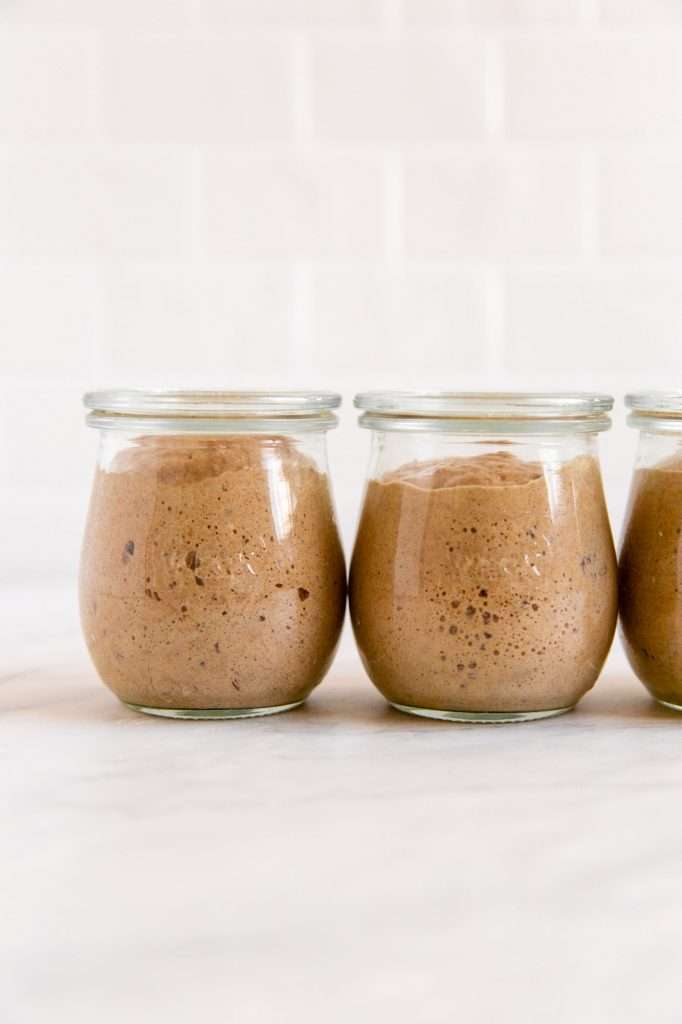

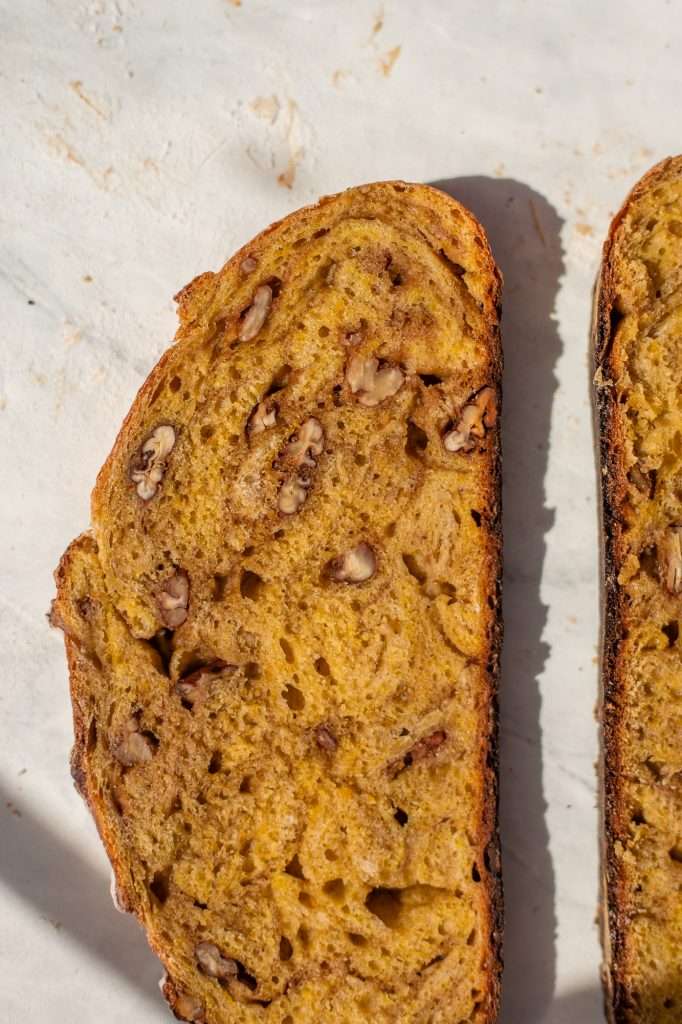

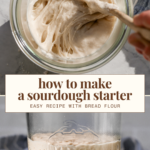
It Would be nice if this was provided in a better printable fashion for my future reference. I had to use a pen to fill in what would not print in some spaces. Thank you for your suggestions and the kraut juice addition I am supposing needs to be from a raw kraut receipe, not cooked after the fermenting process. Thank you, Janet
Hey there! There is a print button at the top of the recipe card. This provides you with a printable version of the recipe. Yes, the sauerkraut needs to be raw and fermented, that’s the only way Lactobacillus will be present in the brine.
Im on day 5(haven’t done the feeding yet) and I feel like it’s not going correctly. It’s not puffing up at all(it did on day 2 but that’s all). It bubbles, but doesn’t expand in size. Whenever I go to get the 50g of starter to feed, it’s got quite a bit of liquid in it and is super stretchy. Is that normal? Should it be smelling yeasty? Im going to keep going hoping I at least get one leavened loaf!!!
If you see bubbles that’s great! and the liquid is normal. It should be bubbly and stretchy. Next time you feed it, you can skip the discard and just feed it…. The night before baking, when you feed the starter without discarding anything, you’ll see it increase in size and it will smell like sourdough.
I live in Hawaii. Our temperature on average has been in the 80’s. I’ve attempted to do this 3 times so far without success. By the second day, there is no action nor any hint of rise. There is some/little hint of bubbling. By the 4th day, I’m not sure what I’m suppose to do, so I start all over again. I have it situated next to my air fryer. We use it occasionally. It’s covered with a lid that is NOT air tight but rather simply placed on top. PLEASE help because I don’t know if I am suppose to keep going or what?!!!
You have some activity so that’s good. Increase the flour and decrease the water on the next feeding. When you mix it, it should be thick like a cookie dough consistency. Then you’ll see a rise.
I know I’m a few years late to the game here, but I was wondering how much you’d increase the flour by? I’m currently following your recipe, and I’m on day #4, and I increased it by almost 20 grams. Is that too much? Do you have suggestions or recommendations for days #5-7?
My starter is 15 months old and recently became very unresponsive after a month of refrigerated neglect. Before giving up, I added some more rye, which I knew it “liked”–except I accidentally grabbed my look-alike blue cornmeal. The starter took off! It took me a day to realize it was cornmeal and not rye that had made my old starter newly lively. Since then, it refuses to “work” until I toss it a handful of cornmeal! I have never heard of this appetite and am wondering what might have happened? BTW it also has taken on a rosy tone which I attribute to pigments in the blue cornmeal, and it smells wonderful, makes a great loaf, so I am not worried that this coloration might be bacterial.
Hey there! Yes, this is quite common and the yeast in starters respond really well to cornmeal. This is because cornmeal has about eight times more sugar per tablespoon. It’s not a large amount of sugar or a noticeable difference to us macroorganisms… but it’s a huge deal to tiny microbes. The pigmentation is definitely from the Anthocyanins in blue corn.
I just mixed up a starter, but it formed a paste/dough. I though it was supposed to be more like a batter to start? Is this okay?
Did you weigh the ingredients? It’s totally fine that it’s thick, you can just add a tiny bit more water to thin out the consistency.
Hi, I am on day 4, and the starter is still a wet, batter-like consistency, some bubbles 2 days ago but no rise and no bubbles last two days. Toward the 24-hour mark I notice separation. I’m measuring accurately and using 50% Maine Grains Rye flour and 50% whole wheat bread flour, and Brita-filtered tap. Not sure if it’s really working out…the amount of starter each day in my 32 oz jars is minimal–from your photos it looks like the jars are full. I’m guessing something has gone wrong? Any advice?
Hello! It should be kind of wet and batter-like. The watery separation is normal, especially if the starter is in a warm place. It’s likely that you are just missing the rise. It won’t stay puffed up and risen for long, so you won’t always see looking as starters look in photos. If you add a bit more flour than water on the next feeding to make it thicker, the rise will hold longer and you’ll be able to see it.
I was using a small jar in these photos, and they were taken when I fed my starter a lot so that I could bake a big batch of bread.
Let me know if you have any more questions and take a look at our blog Sourdough Starter Problems and How to Fix Them
Thanks! I actually ended up seeing the problem-solving post after I sent you my message. I just discarded and fed using only about 60g water this time…much thicker. Really looking forward to eventually baking with it…had to wait to initiate the starter until it was at least 68° consistently in my Maine home, haha. That being said, we’re supposed to have a heat wave (in the 90’s Monday + Tuesday) and my house will probably hit 84° inside as I don’t have central air. 🙁 Should I refrigerate until temps go back down Wednesday?
Thank you for the information on acetone smelling starter. My chemical engineer offspring was quite concerned and was all for getting rid of Gertrude (yes, I named my starter!). So, not only can I say it’s not a problem, but also the solution has come from a fellow scientist!
Happy to help! (and I love your starter’s name!)
I don’t see any yeast in any of the ingredients in these recipes, how does the yeast come in? is this a completely wild start? Is it possible to use these recipes but by using kefir or yeast as an ingredient? If so, what ratio?
Sourdough starters are usually made with just flour and water. There are yeast and bacteria in the flour, and creating a sourdough starter is a means of culturing these microbes. Yes, you can add packaged yeast or kefir of fermented vegetable brine. See the body of this blog post under the heading “Quick Sourdough Starter Recipe Option”
Two additional questions please, I do not see mention of the starter needing to be in any particular temperature. Is it not a factor? Also can this recipe be doubled (starter) without impacting it?
You can absolutely double the recipe! I usually double, sometimes triple, the feeding amounts when I have a lot to bake. Temperature is not that big of a deal. You can grow a starter anywhere from 60-100 degrees F. The temperature just impacts how fast it rises.
I see that you prefer a 50/50 rye flour and bread flour recipe. What water ratio would you use for that? And can I follow this recipe for a starter using those 2 flours?
you can still use a 1:1, so yes you can follow this recipe.
I forgot to feed my starter on Day 2, but added flour and water after realizing it on Day 3. Is this okay? Can I just proceed normally from here or should I start over?
You can proceed normally. It should be fine.
I’m on day 4 and this start is doing great, I read through some of the comments here and learned that I can double or triple feed – that was going to be my question! Thanks for providing such a concise recipe, and for your explanation of how it works. I have killed my start so many times in the last 10 years that I had completely given up on ever learning sourdough, and this gave me the courage to try it again. I named my start and have been really careful to feed it well, plan to put it in the fridge next week and feed it before I need to use it.
Hello! Thanks for all the tips here. I was wondering how long I have to feed my sourdough after bringing it out of the fridge? I did one regular feeding and then a night before baking feeding, and it failed the float test, but there’s still bubbles and it still rose, but not as much as it has in the past days of feeding. Any tips? Do I need to regular feed again for a few days?
Just keep feeding it! If it is bubbling a lot, you can still use it for baking, even if it doesn’t pass the float test.
I would like to keep my sourdough discard for recipes. Right now I’m on day 4 for making my sourdough starter so I don’t have much of a discard but wanting to save it for future recipes. What is the best way to store it? Kept on the counter and sealed/not sealed, or in the fridge?
I like to dump all my discard into one jar that I keep in the fridge.